from the something-worth-fixing dept
When Mark Zuckerberg was called to testify earlier this year, the world was shocked by Congress’s evident lack of basic technological literacy. For many, this performance illustrates the institution’s incompetence. After all, if our elected representatives have trouble understanding how Facebook works, how capable are they of understanding the complexities of the federal government, or crafting legislation across a range of technical subjects?
For those of us who live and work in the “swamp,” the Zuckerberg hearings were no great surprise. Just this year, we’ve seen Congress struggle with technology issues such as quantum computing, cryptocurrencies, and the governance of online platforms. Indeed, it seems effectively incapable of tackling major technology policy issues such as the debate over online privacy, election cybersecurity, or artificial intelligence.
This state of affairs is the product of decades of institutional deterioration, sometimes referred to as the “big lobotomy.” While scholars of American government may offer various books or white papers chronicling this decline, the pattern is evident from a few trends that this post will highlight.
The decline of congressional support agencies
Members of Congress typically come from professional backgrounds in business, law or finance rather than science or technology (for instance, there are currently twice as many talk radio hosts as scientists). To help them understand technical policy issues, Members of Congress and their staff rely on expert advisors in legislative branch support agencies such as the Congressional Research Service (CRS), the Government Accountability Office (GAO), and formerly the Office of Technology Assessment (OTA).
Of the congressional support agencies, CRS is the primary analytical workhorse that supports day-to-day operations, producing digestible reports and timely memos at the request of congressional offices. Unfortunately, the capacity of CRS has declined precipitously in recent decades. From 1979 to 2015, CRS’ staff has shrunk by 28% – a loss of 238 positions.
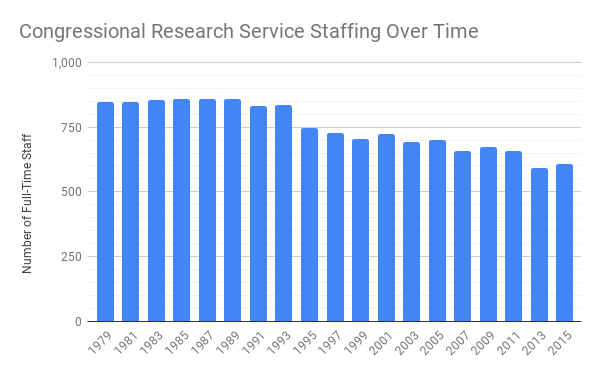
Source: Original chart based on data from the Brookings Institution, Vital Statistics on Congress, Table 5-8.
While CRS serves Congress with responsive memos and digestible reports, it also used to have an agency that conducted deep authoritative technical research. This agency was the Office of Technology Assessment, which for over two decades helped Congress understand the nuances of complex science and technology issues. In 1995, Congress eliminated funding for OTA, creating a gap that has not since been filled.
In addition to needing analysis related to the nuances and tradeoffs of particular regulatory policies, Congress also needs help understanding its $4 trillion in annual federal spending and the sprawling administrative state. To help rein in waste, fraud and abuse, Congress relies on the Government Accountability Office – which is empowered to conduct audits and investigations in the federal government. GAO boasts a savings of “$112 for every dollar invested.” Yet, from 1979 to 2015, its staff has been cut by 44% – a loss of 2,314 positions.
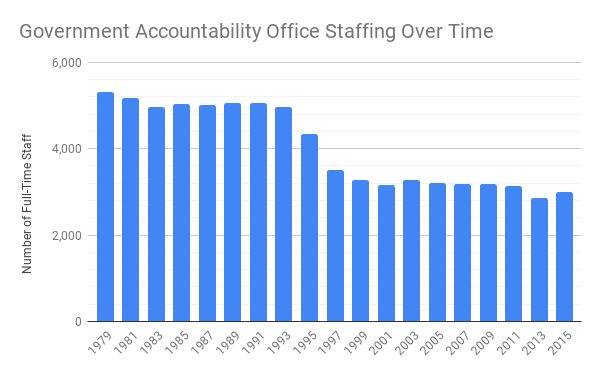
Source: Original chart based on data from the Brookings Institution, Vital Statistics on Congress, Table 5-8.
The decline of congressional committees
A critical source of policy expertise in Congress lies within congressional committees. Yet, like support agencies, committee staffing levels have declined significantly over time. From 1979 to 2015, the number of full-time standing committee staff has shrunk by 38% – a loss of 1,361 positions.

Source: Original chart based on data from the Brookings Institution, Vital Statistics on Congress, Table 5-1.
Key committees for technology policy reflect a similar trend. For instance, from 1981 to 2015 (note: 1979 data for House committees was unavailable), the House Energy and Commerce Committee went from 151 to 83 full-time staff. From 1979 to 2015, its Senate counterpart, the Committee on Commerce, Science, and Transportation, went from 96 to 64 staff. Similarly, from 1981 to 2015, the House Judiciary Committee went from 75 to 61 full-time staff. From 1979 to 2015, its Senate counterpart went from 223 to 91 staff.
With the decline in staffing, committees and subcommittees have also spent much less time conducting hearings, deliberating on policy, and developing legislation. From the 96th Congress (1979-1980) to the 114th Congress (2015-2016), the aggregate number of committee and subcommittee meetings across both chambers decreased by 66%.
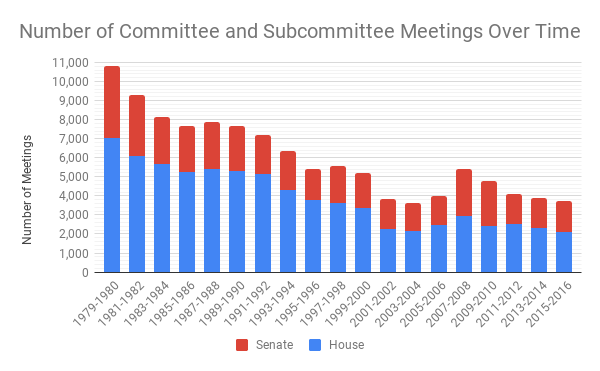
Source: Original chart based on data from the Brookings Institution, Vital Statistics on Congress, Table 6-1 and 6-2.
Additionally, as shown by Casey Burgat and Charles Hunt, committees are also increasingly shifting resources to communications positions over policy roles.
Personal office staff resources are shifting to constituent services
With the rise of new digital tools and a growing population, Congress has been bombarded with a torrent of new communications from constituents and advocacy groups. Per a Congressional Management Foundation study, Congress received four times as many communications in 2004 than in 1995. Responding to this influx, more staff have shifted from policy to constituent relations and communications roles. Legislative staff may also be called more often to assist with constituent work.
This trend can be seen in the percentage of personal office staff based in district and state offices. From 1979 to 2016, the percentage of personal office staff based in district offices in the House of Representatives went from 35% to 47%.

Source: Original chart based on data from the Brookings Institution, Vital Statistics on Congress, Table 5-3.
In the same period in the Senate, the percentage of personal office staff based in state offices has gone from 24% to 43%. Since overall legislative branch staffing and budgets have declined over this period, this trend means fewer resources for retaining policy experts.
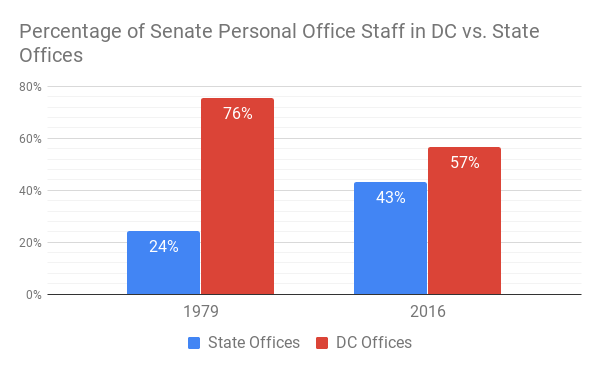
Source: Original chart based on data from the Brookings Institution, Vital Statistics on Congress, Table 5-4.
From 1979 to 2015, the total number of personal office staff has gone from 10,660 to 9,947. Senate numbers have remained relatively stable, since Senate office budgets are tied to population and distance. In the House of representatives, the total number of personal office staff has declined by 15% – a loss of 1,037 positions.
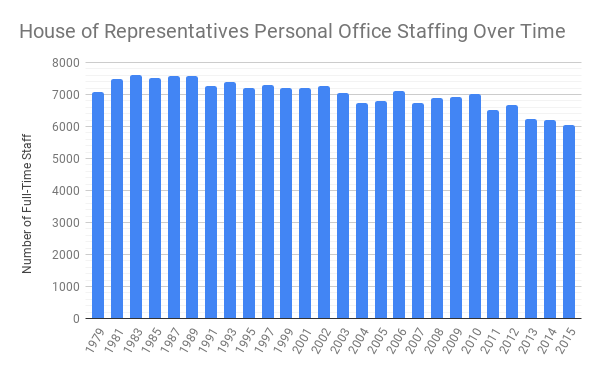
Source: Original chart based on data from the Brookings Institution, Vital Statistics on Congress, Table 5-1.
The decline of legislative branch compensation
In congressional offices, legislative analysis and other policy work falls on a variety of different staff positions. While titles and roles vary by office, these include “legislative correspondent,” “legislative assistant,” “legislative director,” and “chief of staff.” To varying extents, these roles are involved in other activities, such as constituent services, administrative work, and communications.
While cost of living in DC has gone up in recent decades (making it one of the most expensive cities in the country), the overall inflation-adjusted compensation for congressional policy staff has declined.
The median salary for a lawyer in the House of Representatives in 2015 was $56,000. In the private sector in DC, lawyers can easily earn several times that (an attractive exit for many congressional staff). Congressional salaries also fall significantly short of their executive branch counterparts, contributing to an expanding compensation gap. In short, compensation for working in Congress is far below the level needed to attract top talent.
Congressional staff do not believe they have access to sufficient resources or expertise
In a Congressional Management Foundation survey, a group of senior congressional staff were asked about their perspectives on institutional capacity issues. Therein, they rated a range of different areas as either “very important”/”very satisfied” or “somewhat important”/”somewhat satisfied.”
In one question, 81 percent said that access to policy expertise was “very important,” but only 24 percent said they were “very satisfied” with the status quo – a gap of 57 percentage points.
In another question, 67 percent said having adequate time and resources for Members of Congress to consider and deliberate on policy was “very important.” However, only 6% reported that they were “very satisfied” with the status quo.
While congressional capacity has declined, the need for it has increased
The Constitution sets up Congress as the first among three equal branches of government, intending it to lead on policy and provide a check on the executive branch’s potential for waste, fraud and abuse. Unfortunately, Congress has ceded much of its policymaking power and oversight responsibility to the administrative state. As Congress has shrunk over the past few decades, the size and scope of the federal government overall has expanded significantly. For instance, between 1979 and 2014, the U.S. Code of Federal Regulations grew from 98,032 pages to 175,268. Over the same period, inflation-adjusted federal discretionary spending grew from $810 billion to $1,220 billion (in 2017 dollars).
When most of our timeline data begins in 1979, it was just a year after the first computers were installed in the White House. It would still be several years before the introduction of 3 ½-inch floppy disks – which people today only know through the save icon. And it would still be over a decade before the launch of the World Wide Web.
Needless to say, since the late 20th century, the number and complexity of science and technology policy challenges have increased at an accelerating rate. These include issues such as infrastructure cybersecurity, election hacking, artificial intelligence, cryptocurrencies, CRISPR, data privacy, and more. If we’re to maintain America’s lead in innovation and meet the policy challenges of the 21st century, we’ll need to rebuild a capable and expert legislature.
If you’re interested in working on the solution, check out the Future Congress project. This is a new coalition and resource hub working to improve science and technology expertise in the legislative branch.
Zach Graves is head of policy at Lincoln Network. Daniel Schuman is policy director at Demand Progress.
Filed Under: congress, congressional knowledge, future congress, gao, office of technology assessment, ota

